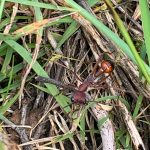Glycine latrobeana (Clover Glycine, Purple Clover)
Another top job by our dedicated team of Landcarers, conducting the annual clover glycine monitoring activity at Porter Scrub. Closely watched by a gorgeous little fella, keen for a bite of the action.
- The Clover glycine count continues. Photo: Kim Thompson
- The happy clover glycine monitors. Photo: Kim Thompson
- Every team needs a supervisor. Photo: Ellen Krahnert
For those who wanted to know a little more about this ‘at risk’ native gem, the following has is an extract from the National Recovery Plan for the Clover Glycine. The full document prepared by the Department of Agriculture, Water and the Environment is available for download from the link below.
The Clover Glycine (Glycine latrobeana) is small perennial herb endemic to south-eastern Australia, where it is occurs in Tasmania, Victoria and South Australia, growing mostly in grasslands and grassy woodlands. The species has suffered an extensive decline in distribution and abundance due to widespread degradation and destruction of habitat. About 140 populations containing about 7,000 plants have been recorded since 1980, but recent estimates have not been made for many populations – National Recovery Plan for the Clover Glycine
The Clover Glycine (Glycine latrobeana) of the Family Fabaceae is a decumbent to ascending herb growing to only a few cm high. Leaves are trifoliate, with sessile to subsessile leaflets 5– 20 mm long and 4–12 mm wide, on petioles 5–50 mm long. Leaflets are of 2 types: leaflets of mature leaves are obovate to more or less orbicular and thin; leaflets of immature leaves are often elliptic with the upper surface glabrous and lower surface with sharp, stiff, appressed hairs. Stipules are suborbicular to broad-ovate or reniform, 1.5–2 mm long, striate. Stipellae are minute and are shed early. Up to eight small, compact, deep purple flowers are borne on peduncles 5–10 cm long. – National Recovery Plan for the Clover Glycine









Leave A Comment